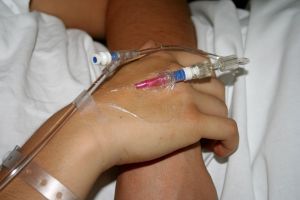At any given time, about 7,500 Americans are actively searching for a bone marrow donor. In July, my friend Fred became one of them.
Bone marrow transplants offer people with leukemia, lymphoma and other potentially fatal diseases a new lease on life. And thanks to the awareness efforts of ABC’s Good Morning America co-host Robin Roberts and her courageous battle against a pre-leukemia blood disease, there has been an outpouring of support for bone marrow donation around the country. ABC News reported a more than 1000 percent increase in registered donors in the days following Roberts’ announcement of her illness.
Although this is an encouraging sign that life-saving bone marrow transplants will now be available to more people who need them, a disturbing trend lurks behind growing donor registries: Many potential donors change their minds and back out of their commitment.
“The national average is that 47 percent of people on donor registries say no when they are asked to donate,” Katharina Harf, executive vice president in the U.S. of the German-based bone marrow organization DKMS, told ABC News.
“Many times, people sign up based on emotional appeal…and then they don’t want to do it,” added Dr. David Cronin, associate professor and director of adult and pediatric liver transplantation at the Medical College of Wisconsin.
To be sure, there are good reasons why people do not honor their pledge to donate marrow. Health problems, pregnancy, or changes in life circumstances may mean donating is no longer an option.
Valid reasons aside, however, reneging on a commitment to donate after a match has been made can have devastating if not life-threatening consequences for cancer patients like my friend Fred.
Fred’s Story
Fred’s roller-coaster journey to wellness began when blood work following a routine physical exam revealed stunning results: Acute Myeloid Leukemia-M6, a rare form of adult leukemia that spurs the rapid growth of abnormal white blood cells which then accumulate in the bone marrow and interfere with the production of normal, oxygen-carrying blood cells.
Fred’s diagnosis was followed in rapid succession by hospitalization, chemotherapy to destroy the cancer cells, soaring temperatures and bouts of infection, drugs that caused hallucinations, and finally, clearance for a bone marrow transplant.
Initially, Fred’s prospects of finding a donor seemed excellent. Doctors identified 20 registered matches and, following insurance guidelines, began the process of investigating the top three candidates. The first two declined, but the third agreed to be a donor. An elated and hopeful Fred began the required round of chemo to prepare for his bone marrow transplant.
A week before the scheduled procedure, however, Fred’s donor backed out, and doctors had to begin the four-to-six week identification process all over again. The search time was just long enough for leukemia cells to return, and Fred had to go through another round of chemo that compromised his immune system and left him vulnerable to infection.
In his most recent weekly email update to friends and family, Fred revealed that the next three candidates on the matched donor list declined and he must undergo another round of chemo.
Good Intentions and misconceptions
There is no doubt that people who register as bone marrow donors are well-intentioned. The idea of saving another person’s life is a powerful motivator. Unfortunately, when it comes time to follow through on their pledge to donate, many potential donors do not understand the process and back out.
“There’s a big misconception that bone marrow donation is painful, said DKMS America’s Harf. “One of the other big misconceptions is that the cells are collected from the spine,” she added.
According to DKMS, there are two ways to donate. The most common way is through peripheral blood stem cell (PBSC) donation, where stem cells are collected via the donor’s blood stream using a process called apheresis. PBSC collection is a non-surgical outpatient procedure that takes about four to six hours on one to two consecutive days.
In the second donation method, liquid bone marrow is collected from the backside of the pelvic bone (not the spine) using a special needle. The procedure is performed under a general anesthesia and generally takes one to two hours. There is no pain during the extraction. Many donors do experience some pain, bruising or stiffness for up to two weeks following donation.
A Commitment to the Next Step
The Be The Match Registry clearly cautions potential donors that, “you are taking the first step to save a life. You are also making a commitment to be ready to take the next step if a patient needs you.” It also advises, “…for all registry members, the most important thing you can do is stay committed, so if you’re selected as a match, you must be ready to move forward.”
Fred remains optimistic and upbeat despite several set-backs. He ends his emails with a hopeful and determined “GAME ON.”
And he waits for one of his donor matches to “move forward.”





